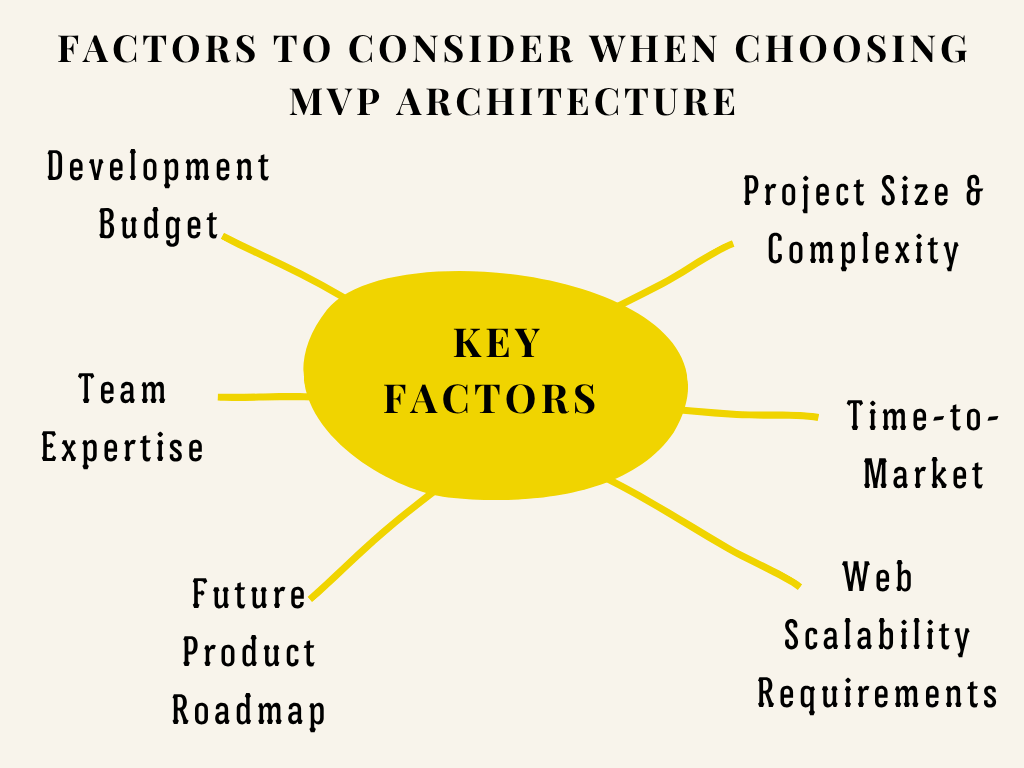Speed is important when launching an MVP, but the architecture behind your app plays a bigger role in long-term success. But beyond design and features, there’s one decision that can make or break your MVP’s future: its architecture.
Choosing the right MVP architecture early ensures your product is scalable, cost-effective, and easier to maintain. Whether you’re a startup building your first prototype or a growing business testing a new idea, understanding architecture choices is essential. The four most popular architectures for MVPs are:
- Monolithic Architecture
- Microservices Architecture
- Service-Oriented Architecture (SOA)
- Serverless Architecture
Let’s explore how each architecture aligns with your MVP goals.
What is MVP Architecture?
MVP architecture refers to the foundational structure that dictates how different components of your application interact. It determines the organization of your code, how services communicate, and how your app handles traffic, scalability, and deployments.
Choosing the right architecture can accelerate your development timeline, reduce technical debt, and provide a flexible structure for future scalability. In contrast, a poorly selected architecture may limit the product’s ability to grow, introduce performance bottlenecks, and increase the cost of future updates.
The key benefits of a well-structured MVP architecture include:
- Faster Development Cycles: A clearly defined structure simplifies the MVP development process and helps reduce overall build time.
- Reduced Initial Costs: Simpler MVP design patterns keep infrastructure and development expenses lower in the early stages.
- Scalability: Selecting a suitable MVP design ensures your solution can grow alongside user demand without requiring a complete overhaul.
- Improved Maintainability: With modular MVP development architecture, updates become more efficient and less error-prone.
- Efficient Deployment: Using a robust MVP application architecture supports smoother CI/CD pipelines and automation.
A good architecture doesn’t just serve the present; it should enable seamless expansion in the future. Learn how to build your product faster and better with our custom MVP development services and detailed MVP development guide.
Key Factors to Consider When Choosing MVP Architecture
The architecture you choose should reflect your project’s specific goals and constraints. Use these factors to guide your decision:

1. Project Size & Complexity:
Smaller MVPs benefit from simpler architectures like Monolithic, while complex systems may require Microservices.
2. Time-to-Market:
A short timeline may favor Monolithic or Serverless options that are quicker to implement.
3. Scalability Requirements:
Anticipating high user volume or future expansion? Microservices or Serverless may serve better.
4. Development Budget:
Limited funds may dictate a leaner architecture initially, with plans to evolve later.
5. Team Expertise:
The skill level of your developers matters. Don’t pick a complex architecture if your team lacks experience.
6. Future Roadmap:
Is this MVP likely to become your flagship product? Choose an architecture that supports long-term evolution.
For deeper insight into MVP budgeting, explore our blog on MVP development cost.
Overview of Common MVP Architectures
Below is an overview of the four main MVP architectures. You’ll find a full comparison in the next section.
1. Monolithic Architecture
A single, unified application where all components (UI, backend, database) are tightly coupled into one deployable unit.
Why Choose It:
Monolithic architecture is often preferred for MVPs due to its simplicity and speed of development. You can manage your app with a single codebase and easily deploy the entire system.
Pros:
- Easy to develop with smaller teams
- Lower initial setup and hosting costs
- Faster time-to-market due to reduced complexity
Cons:
- Scaling specific features is hard
- Tightly coupled components reduce flexibility
- Any failure can impact the entire app
Use Case:
Perfect for startups testing basic functionality and seeking quick market feedback.
Learn how you can leverage front-end efficiency with React Native App Development when building Monolithic MVPs.
2. Microservices Architecture
This approach splits an application into a collection of small, independent services that communicate via APIs.
Why Choose It:
Microservices are ideal for scalable products. Each module or service can be developed, tested, deployed, and scaled independently.
Pros:
- Supports large teams working in parallel
- Services can be reused across projects
- Resilient: one service failure doesn’t crash the whole system
Cons:
- Requires sophisticated DevOps and CI/CD pipelines
- Increased infrastructure management
Use Case:
- Choose Microservices if you’re building a high-traffic MVP or a product intended to evolve into a complex platform.
- Our MVP Development Services help you design a scalable MVP application architecture using Microservices efficiently.
3. Service-Oriented Architecture (SOA)
SOA consists of loosely coupled services communicating via a common interface, typically over a service bus or API gateway.
Why Choose It:
SOA is suitable for large organizations that need to integrate various business applications or leverage existing infrastructure.
Pros:
- Integrates seamlessly with legacy systems
- Promotes modular development
- Easier to upgrade and maintain specific components
Cons:
- Complexity in orchestration and governance
- May require middleware and API management tools
Use Case:
Ideal for enterprises modernizing legacy systems and needing to centralize services.
Discover how our cloud computing services can enhance your MVP development architecture when adopting SOA.
4. Serverless Architecture
Serverless computing allows you to build and run applications without managing servers. Functions execute on demand via platforms like AWS Lambda, Azure Functions, or Google Cloud Functions.
Why Choose It:
Serverless is optimal for applications with unpredictable traffic or event-driven logic. You only pay for what you use.
Pros:
- High scalability out of the box
- Reduced operational burden
- Excellent for low-latency applications
Cons:
- Cold start issues can affect performance
- Vendor lock-in risks
Use Case:
Perfect for lightweight MVPs with minimal backend logic or apps needing rapid deployment.
Learn more about the serverless architecture benefits and how they shape flexible MVP design patterns.
Monolith vs Microservices vs SOA vs Serverless: Side-by-Side Comparison
Architecture | Cost | Scalability | Time to Market | Complexity |
| Monolithic | Low | Low | Fast | Low |
| Microservices | High | High | Moderate | High |
| SOA | High | Medium | Moderate | Medium |
| Serverless | Low | High | Fast | Moderate |
Real-World Examples
- Monolithic: Craigslist, early Shopify
- Microservices: Uber, Netflix
- SOA: Banking and government applications
- Serverless: Startups using AWS Lambda, Firebase
Want to build something similar? Our Mobile App Development team can help craft the right MVP development architecture tailored to your needs.
How to Choose the Right Architecture for Your MVP
Ask These Questions:
- What are your core MVP goals? (Speed, scalability, ease of maintenance)
- How complex is the MVP feature set?
- What budget and technical resources are available?
- Is the MVP likely to scale significantly in the near future?
Decision Tree Summary:
- Choose Monolithic → If you need fast delivery and have a tight budget.
- Choose Microservices → If you seek flexibility and plan for long-term growth.
- Choose SOA → If you’re focusing on system integration and enterprise compliance.
- Choose Serverless → If you’re building dynamic apps with low overhead and want instant scalability.
For tailored recommendations, consult our MVP Development Services.
Common Mistakes to Avoid
- Overengineering MVPs with complex architectures prematurely
- Skipping future-proofing, resulting in costly rework
- Neglecting developer experience, making maintenance difficult
- Choosing based on trends, not product goals
Reduce risk with our proven Mobile App Development Process and align it with an effective MVP application architecture.
Future-Proofing Your MVP Architecture
Ensure your MVP is ready for the next stage of growth with these strategies:
- Start with a modular monolith for easier migration to Microservices
- Implement Docker containers to isolate services early
- Use cloud-native tools like Kubernetes and CI/CD pipelines
- Plan for a scalable architecture roadmap from day one
We offer end-to-end modernization through our LLM Development Services and enterprise-grade integrations that support robust MVP design patterns.
Final Thoughts
Choosing the right MVP design pattern and architecture is foundational to success. Each architecture has unique strengths and weaknesses, and your decision should reflect your MVP’s specific goals, resources, and trajectory.
Whether you’re validating a new idea or scaling an existing solution, having the right structure will save time, reduce cost, and drive better performance.

Partner with Experts
Frequently Asked Questions
How is SOA different from Microservices?








SOA focuses on enterprise-wide service integration via a central bus, while Microservices are independently deployed units designed for agility and scalability.
Is it advisable to use a hybrid architecture for an MVP?














Yes, a hybrid approach can combine speed with flexibility, but it must be well-planned to avoid unnecessary complexity.
How does DevOps affect architectural decisions for MVPs?














Robust DevOps practices support complex architectures like Microservices, enabling smoother deployments, automation, and scalability from the start.
How does architecture affect the MVP development cost?














Simpler architectures like Monolithic reduce upfront costs, while Microservices or SOA may require a higher initial investment due to infrastructure and management overhead.
What are the pros and cons of using Serverless architecture for an MVP?














Serverless offers rapid deployment and cost-efficiency but may face cold start delays and vendor lock-in concerns.
Which architecture is best suited for an MVP: Monolithic, Microservices, SOA, or Serverless?














It depends on your MVP's goals. Monolithic is best for speed and simplicity, while Microservices and Serverless support scalability and modular growth.


